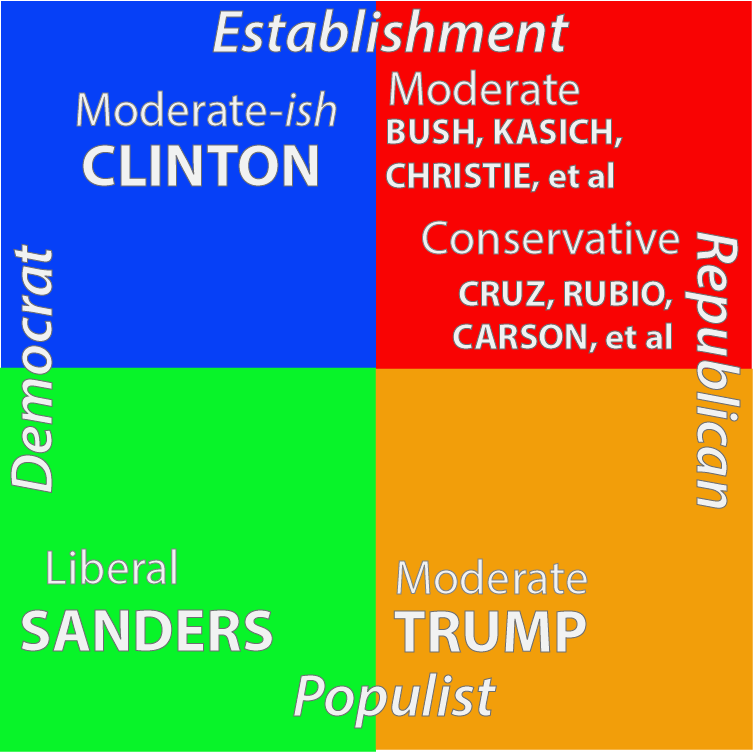I wrote an earlier blog post saying the recent presidential election was not different from previous elections for me because, while I was not entirely happy with the Republican nominee this time, I have not been entirely happy with the Republican nominee in any election since 1984.
However, this election WAS different in a very important way.
Whereas usually presidential elections can be analyzed as binary events, with a liberal-to-moderate Democrat vs. a moderate-to-conservative Republican, this election was different. Yes, I know there are usually third and fourth party candidates in the mix, but they rarely impact the outcome.
Because both major parties had very raucous primary seasons, and because the eventual Republican nominee and election victor was so unexpected, I see this election differently. I’ve created a chart to show how I think it was different.

Instead of a binary division I think this time there were four quantrants, with the top two quandrants being “Establishment” and the bottom two “Populist”. The right quandrants were Republican and the left Democrat. You can see from the grid where I place each of the candidates. (Yes, I know I left people out, including the Libertarians and Greens. They just didn’t figure in for most voters.)
It seems to me that Trump and Sanders were two sides of the same Populist coin. Neither was truly established in the party for whose nomination they were running. Trump has voted Democrat most of his life and Sanders is a proud Socialist. Each of them were free to take whatever position they thought was important or would play well with voters. They usually had different solutions but they often agreed on the nature of the problems.
In the two Establishment quadrants, the candidates were much more tied to their respective parties, and in this election that was a real disadvantage. On the Republican side, Trump was able to paint his rivals as beholden to special interests and the policies of the Bush administration. Prominent Republicans reacted, some even pledging to vote for Clinton or the Libertarian nominee. For the Democrats, Sanders came very close to upsetting the anointed Hillary Clinton, by pounding her connection to Wall Street and the Washington elite. Sanders might have won the nomination if the party and the press had not aided and abetted Clinton.
So, I believe this election was not so much Republican vs. Democrat as Establisment vs. Populist. In then end, Trump won by pulling voters from each of the four quandrants: 10% of Bernie Sanders’ primary voters voted for Trump in the general election. The number of Democrats who voted for Trump reminded one of Reagan. More African-Americans voted for Trump than for Romney four years ago. A surprising 29% of Hispanics voted for Trump; surprising because the conventional wisdom was that no Hispanic would vote for Trump because of his intention to secure the southern border with Mexico. And of course, he got the majority – but not all – of the Republican vote.
The big loser was not just the Democrat party, but the Democrat signature idea of identity politics. Clinton’s candidacy was predicated on the fact that she was a woman and the party and the campaign tried unsuccessfully to paint Trump as a sexist (unsuccessfully as far as the final vote was concerned at least). While Clinton won the women’s vote, Trump’s share was only two percentage points less than Romney’s and he actually won among white women.
With almost one-third of Hispanics voting for Trump, the Democrats failed to convince voters that Trump’s promise to build a wall was racist. Hispanics showed that they are not monolithic and those here legally are just as concerned about illegal immigration as anyone else.
African-American Trump supporters were more vocal in their support for a Republican nominee than they have been since the 1960s. Social media postings by Black Trump supporters were more numerous than ever before as I noted previously.
All this means that the Democrats need to realize that treating people as members of groups with monolithic opinions is, in fact, bigoted and condescending. Take the African-American community, for instance. It is indeed condescending in the 21st century to believe that the only thing Blacks care about is welfare when today African-Americans may hold any type of job and many are entreprenuers making enough money to turn them into Libertarians when it comes to taxes. Their pocket-book issues may actually be the opposite of what Democrats think they are. Many African-Americans have much more in common with middle-class whites on economic issues than they do with poor Blacks.
Then there’s religion. Many African-Americans are conservative Christians. As the Democrats become more and more extreme on the topics of abortion and removing all references to God from public life, more and more Black pastors and their congregations will be unable to support them.
Republicans need to learn the lessons of this election as well. They need to understand that their timidity and moderation in past elections and in governing will not serve them well in the future. Trump has shown that it is time for bold and decisive leadership, regardless of how politically incorrect it may be for the Establishment in both parties.
Leave a Comment


